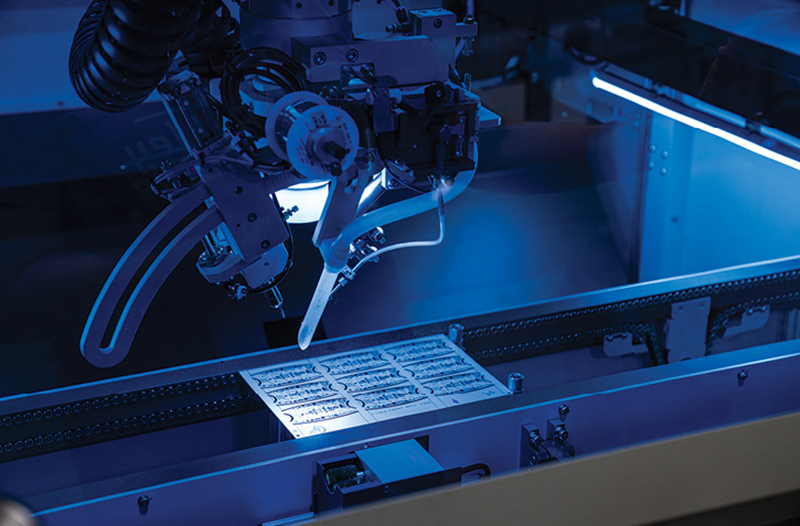Controlling the Scene Brian Boardman
Firefighters and other first responders rely on a slew of equipment to do their jobs and help them stay safe. From the gear they wear to the apparatus and tools they use, there are many manufacturers involved in creating these products.
Those in the fire industry have a lot of options when it comes to choosing the right products and manufacturers for their needs. Let’s talk about how some manufacturers set themselves apart from the rest and discuss a few important considerations before making your next purchase.
It’s no secret that the pandemic opened many people’s eyes to the downsides of manufacturers choosing to offshore. The perceived advantage of lowering costs was overshadowed by supply chain shortages, production delays, poor communication, and lack of quality control among other things. However, the pandemic also gave us an opportunity to see the flip side, as the manufacturers that have invested time and resources to vertically integrate their businesses were much more nimble and able to deliver consistent quality and output.

1 A panel of nine M2 lighthead printed circuit assemblies is located in a robotic soldering machine at the Whelen Charlestown, New Hampshire, facility. LEDs and other components have been installed in a previous process (SMT line), and the wires have been inserted by hand prior to this step. Six wires on each assembly will be permanently attached to the printed circuit board with this precise, automated, controlled process. (Photos courtesy of Whelen.)

2 A Whelen employee inspects lenses that have just gone through the hard-coating process in its New Hampshire facility.
VERTICAL INTEGRATION IS GOOD FOR CUSTOMERS
Vertical integration occurs when a company controls multiple stages of the supply chain, from raw materials to the final product or service. This integration can benefit customers in many ways including consistent quality, faster response times, customization, and cost control. Those manufacturers that have greater control over their production processes can ensure the same level of quality throughout all stages. They can also respond more quickly to changes in demand, market trends, or customer preferences. This agility can result in faster product development and delivery to customers.
MANUFACTURED IN AMERICA MEANS MORE THAN “ASSEMBLED HERE”
There is an enormous difference between molding, bending, and building parts from scratch to create products from the ground up vs. importing parts from overseas and assembling the products in a warehouse in the United States. For all the reasons I just mentioned and more, the vertical integration of American manufacturers is key to ensuring customers get high-quality and consistent products they can rely on.
Controlling multiple stages of the supply chain also fosters innovation. Manufacturers can experiment with new materials, processes, and technologies without depending on external suppliers, leading to the development of unique and improved products. In these environments, communication between different stages of production is also smoother, resulting in fewer errors; reduced misunderstandings; and, ultimately, a better experience for customers.
AUTOMATION ENHANCES EMPLOYEE CAPABILITIES
When manufacturers talk about automating processes, the conversation almost always involves a discussion about how the new processes will impact their workforces. Traditionally, this kind of talk makes employees nervous about the security of their jobs. The good news is that like technology in other industries, automating repetitive tasks, in the manufacturing of warning lights for example, enhances employees’ capabilities by freeing them up to work on more complicated assignments. Plus, repetitive tasks are often mundane and leave people feeling mentally and physically exhausted. Automation allows them to focus on more creative, complex, and intellectually stimulating aspects of their jobs.
In addition, workers often need to acquire new skills to operate and maintain automated systems. This drives the need for continuous learning and upskilling, which can make workers more valuable and adaptable in the job market. Many companies invest in training programs to help their employees acquire these new skills.
For example, Whelen Engineering recently completed an upgrade of one of its eight surface mount technology (SMT) production lines, which has led to improved accuracy as well as increased speed and capabilities, with throughput (the number of items passing through a system) more than doubling. The company reduced operator involvement in a monotonous task while also decreasing changeover time on the line. Employees who work on the SMT line received on-the-job training and added new skillsets to their knowledge base. “Education and workforce development are critical to our long-term success,” says Whelen’s Electronics Production Manager James Blundon. “We have many employees who started at Whelen with no specialized skills who are now programming and running very complex equipment. Connecting those employees with ongoing training and opportunities for advancement helps us unlock that untapped potential.”
MANUFACTURERS CAN MEET CHANGING DEMANDS
Automation also allows for more flexibility in operations, which is good for customers. Tasks can be adjusted quickly to meet changing demands, and manufacturers can pivot more easily in response to market fluctuations. Combine that with the fact that these systems are less prone to errors than those that rely on manual processes, which results in higher quality products and services, and automation is a trifecta for customers, companies, and their workforces.
TRUST AND REPUTATION MATTER
Becoming a successful, vertically integrated American manufacturer does not happen overnight. Companies continue to invest in a future that places a high value on people and processes. They’ve worked hard for decades or longer to produce high quality products, build strong reputations, and ensure their customers’ trust. These manufacturers are using their hard-earned expertise to problem-solve and develop the next generation of products in a way that benefits everyone around them. The next time you’re looking to purchase a product, take a moment to consider not only who manufactures it but how they manufacture it.
BRIAN BOARDMAN is the senior vice president of operations for Whelen Engineering, Inc. He has been instrumental in building Whelen’s infrastructure and capabilities, including facility expansions, production layout, and automation efforts.

